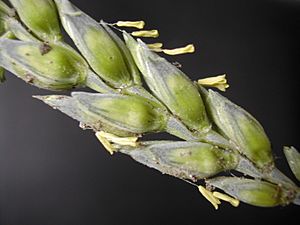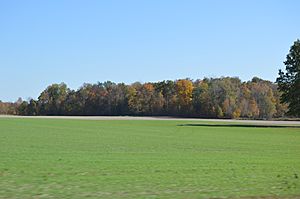Winter wheat facts for kids
Winter wheat is a special type of wheat. It is usually planted in the autumn. The young plants grow a little before winter. Then they stop growing during the cold months. They start growing again in early spring. This type of wheat is different from spring wheat. Spring wheat is planted in the spring.
Winter wheat needs a cold period to grow properly. This cold period is called vernalization. It means the plant needs 30 to 60 days of cold temperatures. These temperatures are usually between 0°C and 5°C (32–41°F). After this cold period, the plant can start making its grain.
Winter wheat is usually planted from September to November. This is in the Northern Hemisphere. It is then harvested in the summer or early autumn of the next year. Winter wheat often produces more grain than spring wheat.
Some types of wheat are called "facultative" varieties. These need a shorter cold period. They only need 15 to 30 days of cold. The temperatures can be a bit warmer, from 3°C to 15°C (37–59°F). These varieties can sometimes be grown as either winter or spring wheat. It depends on when they are planted.
In places with mild winters, like South Asia or the Middle East, spring wheat is sometimes planted in the autumn. This spring wheat is harvested the next year. People sometimes incorrectly call this "winter wheat." But it does not need the cold period that true winter wheat does.
Contents
Types of Winter Wheat
Different kinds of winter wheat are used for different foods.
- Hard winter wheats have a lot of gluten. Gluten is a protein that helps dough stretch. These wheats are great for making flour for yeast breads.
- Soft wheats have less gluten. They are used for special flours, like cake flour.
- Durum wheat is the hardest wheat. It is mostly used to make pasta. Most durum wheat in North America is planted in the spring.
Winter wheat is grown in many places. You can find it across Europe, North America, and in Siberia.
Growing Winter Wheat
Winter wheat can be grown for different reasons. It can be a cash crop, meaning it is grown to be sold. It can also be a cover crop. A cover crop helps protect the soil.
Best Growing Conditions
Winter wheat grows best in soil that drains water well. The soil should not be too heavy or too light. It needs enough nutrients, especially nitrogen. This helps the wheat grow strong before winter. A firm seedbed also helps protect the wheat during the cold winter months.
Benefits of Winter Wheat
Growing winter wheat has many good points:
- Protects soil: If used as a cover crop, it stops soil from washing away in winter. This is when many fields are empty. It helps keep the good topsoil in place.
- Fights weeds: Winter wheat grows strong and can out-compete many types of weeds.
- Flexible use: It can be both a cover crop and a crop to sell.
- Easy to manage: It is fairly easy to grow and still gives a good harvest.
- Builds soil: It adds a lot of plant material back into the soil. This helps make the soil healthier. It also helps cycle nutrients through the soil.
- Uses water well: It starts growing earlier in the spring. This means it can use the soil's moisture more efficiently.
- Earlier harvest: The crop is ready earlier in the season. This is helpful in places where autumns are rainy.
Winter Wheat in the United States
Winter wheat was first brought to Kansas by German-Russian Mennonites. This happened in the 1800s. Two important people helped spread winter wheat as a major crop.
Bernhard Warkentin set up mills in Kansas. He brought wheat seeds from Ukraine to meet the growing demand. Mark A. Carleton worked for the United States Department of Agriculture (USDA). He traveled to Russia to find new wheat types. He also worked with researchers at Kansas State University to create even better varieties.
Winter wheat quickly became popular across the Great Plains. It was, and still is, often grown using dryland farming methods. This means growing crops without extra irrigation.



